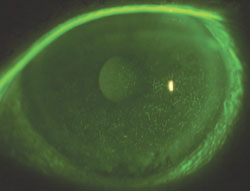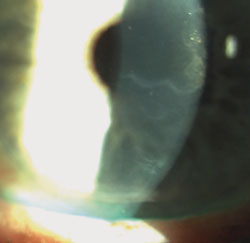Dry eye treatment options expand with nontraditional options
Consider oral and experimental therapy for these patients.
Unusual treatment protocols are emerging for dry eye that does not resolve with traditional treatment options. The use of steroids, systemic medications, supplements and platelet-rich autologous plasma make patients with unresolved cases of dry eye more comfortable.
Dry eye response
Various factors can complicate the treatment of dry eye. Autoimmune diseases such as Sjögren’s syndrome and rheumatoid arthritis are well known contributors to dry eye, as are acne rosacea and atopy. Systemic disease, medication, a patient’s diet or their daily activities such as smoking or cosmetic application could also be factors, Gregory S. Moore, OD, told Primary Care Optometry News.
“When a patient comes in with dry eye, we try to uncover any possible explanations as to why the patient could be having these problems,” Dr. Moore said. “If an eye is already compromised, even a small reaction could be exacerbated in someone who already has those issues.”
The solution could sometimes be as simple as asking the patient to use the same brand of make-up around the eye. “There’s the possibility that different brands of make-up are interacting and causing a problem,” Dr. Moore said. “The U.S. Food and Drug Administration only requires companies to test the brands against themselves, so you never know if what you’re using could be causing some type of chemical reaction.”
Cornerstone therapies
Restasis (cyclosporine ophthalmic emulsion, Allergan) is a cornerstone of Dr. Moore’s dry eye practice. Combined with Azasite (azithromycin 1% ophthalmic solution in DuraSite, Inspire) to reduce inflammation, resolution for patients with mild dry eye disease can be achieved, he said. In moderate cases, steroids should be added.
 Figure 1. Dense superficial punctate keratitis can occur secondary to dry eye syndrome.  Figure 2. Anterior basement membrane dystrophy presents with the classic “mare’s tail defect.” Images: Bailey G |
“Steroids are an absolute must in any moderate to severe cases. Current research shows steroids will go into epithelial corneal cells and prevent MMP-3 and MMP-9 production,” Dr. Moore said during a presentation at the 2009 Optometric Council on Refractive Technology annual symposium. “They’re required at a certain level for the ocular surface to maintain homeostasis, but too much or not enough will contribute to the inflammatory process.”
A topical steroid such as Lotemax (loteprednol etabonate ophthalmic suspension 0.5%, Bausch & Lomb) is safe and effective for the treatment of corneal and intraocular inflammation and has few side effects, Dr. Moore said.
Dry mouth treatments for the ocular surface
For more severe cases that do not resolve using this treatment protocol, recent studies have shown that cevimeline capsules or pilocarpine tablets — which are typically prescribed for Sjögren’s syndrome — may help stimulate tear production in patients suffering from dry eye disease.
According to a randomized controlled study by Tsifetaki and colleagues involving 85 female patients with Sjögren’s syndrome, patients taking oral pilocarpine showed significant improvement in their subjective dry eye symptoms and objective improvement as measured by the rose bengal test (P < 0.05).
“Salagen [pilocarpine HCl, MGI Pharma] and Evoxac [cevimeline HCl, Daiichi] work very well with hardly any side effects. Evoxac is recommended three times daily, but I prescribe it twice a day initially and adjust the dose based on the patient’s response,” Dr. Moore said.
According to the Tsifetaki study, there was no evidence that oral pilocarpine increased tear production.
Autologous eye-platelet rich plasma
Commonly used in orthopedics, autologous plasma enriched with platelets and growth factors has been introduced to eye care for wound healing, corneal ulcers and dry eye.
Jorge L. Alió, MD, PhD, outlined the healing ability of eye-platelet rich plasma (E-PRP) at the 2010 World Ophthalmology Conference in Berlin.
“Platelets are great reservoirs of growth factors that enhance proliferation and wound healing in both soft and hard tissues,” Dr. Alió said during his presentation. “These factors induce mesenchymal and epithelial cells to migrate and proliferate, restoring the damaged ocular surface.”
E-PRP is created from a patient’s own blood, which is drawn and spun to remove white and red cells, leaving a translucent yellowish plasma rich in platelets and growth factors, Dr. Alió told PCON. After centrifugation, the plasma is placed into sterile eye droppers for topical administration. The plasma is not diluted, so the product becomes 100% autologous, without additives.
According to Dr. Alió and colleagues, autologous E-PRP in the form of topical eye drops should be used for dry eye, ocular surface complications after LASIK and dormant ulcers. Dr. Alió’s study published in Ophthalmology found that autologous E-PRP promoted the healing of dormant corneal ulcers in cases of corneal perforation and reduced pain and inflammation.
“Platelet rich plasma improved photophobia, pain and inflammation; facilitated reepithelialization; promoted corneal wound healing; improved clinical conditions; and resulted in improved vision in the majority of the patients included in the study,” the authors said.
For severe dry eye patients who do not resolve using other methods, Dr. Moore recommends this plasma.
“When you have a compromised eye, there are no nutrients getting in there to promote healing, so you have a vicious cycle where the tissue continues to break down. By applying this autologous plasma directly to the eye, the eye will heal in a lot of cases where we’ve never been able to see it heal before,” Dr. Moore said.
A study by Kojima and colleagues found autologous plasma eye drops to be effective for treating dry eye disease by improving tear stability and ocular surface vital staining scores. The study authors found autologous plasma to be “superior to conventional treatment” for improving ocular surface health and subjective comfort.
Proactively diagnose patients
According to Dr. Moore, recent studies indicate that about 25% of patients have varying degrees of dry eye. Though many are hesitant to seek treatment, others are unaware of the signs and symptoms of dry eye disease. Doctors can improve their patients’ health and their own bottom line by watching closely for ocular surface problems.
“Doctors need to be addressing the problems of this undertreated condition now that we have ways to treat it,” he said. “We need to be more proactive about uncovering the patients who are having dry eye problems, because it’s a progressive disease that is only going to get worse. The sooner doctors are able to manage it, the longer their patients will have comfortable vision without the severe complications of dry eye.” — by Stephanie Vasta
References:
- Alio JL, Abad M, Artola A, et al. Use of autologous platelet-rich plasma in the treatment of dormant corneal ulcers. Ophthalmology. 2007.114:1286-1293.
- Kojima T, Ishida R, Dogru M, et al. The effect of autologous serum eye drops in the treatment of severe eye disease: a prospective randomized case-controlled study. Am J Ophthalmol. 2005;139:242-246.
- Tsifetaki N, Kitsos G, Paschides CA, et al. Oral pilocarpine for the treatment of ocular symptoms in patients with Sjögren’s syndrome: A randomised 12-week controlled study. Ann Rheum Dis. 2003;62:1204-1207.
- Gregory S. Moore, OD can be reached at West Virginia Laser Eye Center, 50 Riverwalk Mall, South Charleston, WV 25303; (304) 768-7902, fax: (304) 768-7932; drmoore@wvlec.com.
- Jorge L. Alió, MD, can be reached at Vissum, Corporacion Oftalmologica, Avda. de Denia, s/n, 03016 Alicante, Spain; 34-965-150-025; fax: 34-965-151-501; jlalio@vissum.com.

